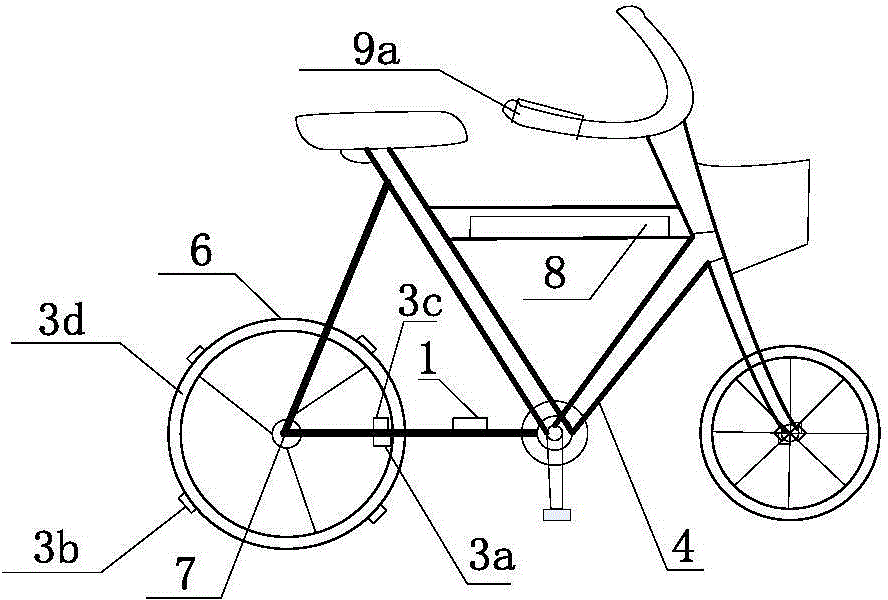Electric device, electric vehicle and method for driving and braking electric device and electric vehicle and extending ranges of electric device and electric vehicle
A technology of electric devices and electric vehicles, which is applied in the direction of electric vehicles, power devices, control drives, etc., to achieve the effects of simple structure, short mileage and diversified combinations
- Summary
- Abstract
- Description
- Claims
- Application Information
AI Technical Summary
Problems solved by technology
Method used
Image
Examples
Embodiment 1
[0094] A kind of electric device is arranged on the two-wheeled vehicle of rear wheel, and the partial structure of matching vehicle frame 4 is as follows Figure 1d As shown, the circumference of the wheel is 1000mm, and the battery pack 8b is a 24V12Ah lithium iron phosphate battery installed inside the frame. The rotating body 6 of the electric device is an annular titanium-aluminum alloy ring with a rotating shaft and a circumference of 100mm. The coaxial 7 in the rotating body is equipped with a disc with a fixed shaft. The external mechanical parameters of the fixed shaft of the disc refer to the supporting two wheels. The data design of the car is used to replace the fixed wheel shaft of the conventional two-wheeled vehicle and installed. A stator unit 3a is installed on the disk; a deceleration / torque conversion device 2 composed of several gears is arranged on the outside of the rotating body. The swivel body is installed at the center of the shaft, and the reduction ...
Embodiment 2
[0102] An electromagnetic braking function is added to the electric device of embodiment 1.
[0103] The electromagnetic braking device 9b of the electric vehicle is a ten-stage rheostat, and the power modulator increases the braking signal input terminal 1e to be electrically connected to the electromagnetic braking device; when the electromagnetic braking device is manually controlled to send a braking signal, the power modulator cuts off T 1 corresponding to the timing current, start T 2 Time domain power supply, the power supply time domain is set as the time period when the sensing unit 3c senses the rotor unit 3b around the axis to the position where θ is from 30 degrees to θ is 0.
[0104] The brake current output by the power modulator corresponds to the ten-level resistance of the electromagnetic braking device 9b, which is set to ten-level intensity. The set output current intensity is: the first level is 5A, the last level is 16A, and the ten-level current is set on...
Embodiment 3
[0107] The braking logic of the electric device in Embodiment 2 is further optimized as follows: the power modulator starts T 2 While powering up in the time domain, the T 0 part of the time-domain operating logic is switched synchronously for power-up, the T 0 Part of the time domain value and (T 1 +T 2 ) are equal, T 0 The moment of energization starts when θ is 0; the power modulator starts at this T 0 The current intensity output in part of the time domain is related to T 2 Same time domain.
[0108] In this embodiment, the braking energization of the windings of the stator unit increases the time domain in which the rotor unit and the stator unit are in a state of separation, and strengthens the effect of electromagnetic force braking. The braking energization time domain can also be briefly set corresponding to the periodic sequence T as: at (T 1 +T 2 +T 0 ) sequence, the first 1 / 3 time domain is powered off, and then the 2 / 3 time domain is powered on. The afor...
PUM
 Login to View More
Login to View More Abstract
Description
Claims
Application Information
 Login to View More
Login to View More - R&D
- Intellectual Property
- Life Sciences
- Materials
- Tech Scout
- Unparalleled Data Quality
- Higher Quality Content
- 60% Fewer Hallucinations
Browse by: Latest US Patents, China's latest patents, Technical Efficacy Thesaurus, Application Domain, Technology Topic, Popular Technical Reports.
© 2025 PatSnap. All rights reserved.Legal|Privacy policy|Modern Slavery Act Transparency Statement|Sitemap|About US| Contact US: help@patsnap.com



